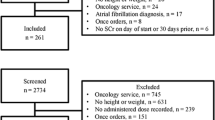Abstract
Treatment of venous thromboembolism (VTE) has been confined to parenteral agents and oral vitamin K antagonists for decades; however, with the approval of the direct oral anticoagulants (DOACs), clinicians now have more options. This study aims to evaluate the real world prescribing practices of all oral anticoagulants for VTE at a single center. A retrospective cohort analysis of all adult patients diagnosed with acute onset VTE was conducted. Of the 105 patients included in the analysis, 45 (43 %) patients received warfarin and 60 (57 %) patients received a DOAC. Rivaroxaban and apixaban were the most common DOACs initiated. There were significantly more patients in the warfarin group with an eCrCl of <60 ml/min compared to patients who received a DOAC (77.8 % vs. 15 %; P < 0.05). There were significantly less patients in the warfarin group with serum aminotranferase concentrations three times the upper limit of normal compared to those who received a DOAC (15.6 % vs. 55 %; P < 0.05). Patients who received a DOAC had less days on parenteral anticoagulation compared to patients who received warfarin (median 2.5 days [IQR 0–4] vs. 6 days [IQR 5–7], p < 0.05). Patients who received a DOAC had a shorter hospital length of stay compared to patients who received warfarin (median 3 days [IQR 2–4] vs. 8 days [IQR 6–10], p < 0.05). This analysis showed that DOACs are being prescribed more than warfarin for treatment of new onset VTE. Renal and liver function may influence the agent prescribed. Utilization of DOACs may decrease the hospital length of stay.

Similar content being viewed by others
References
Piazza G et al (2009) Venous thromboembolic events in hospitalised medical patients. Thromb Haemost 102(3):505–510
Heit JA (2006) The epidemiology of venous thromboembolism in the community: implications for prevention and management. J Thromb Thrombolysis 21:23–29
White RH (2003) The epidemiology of venous thromboembolism. Circulation 107(23 Suppl 1):I4–I8
Goldhaber SZ, Bounameaux H (2012) Pulmonary embolism and deep vein thrombosis. The Lancet 379(9828):1835–1846
Johnson JA et al (2011) Clinical Pharmacogenetics Implementation Consortium Guidelines for CYP2C9 and VKORC1 genotypes and warfarin dosing. Clin Pharmacol Ther 90(4):625–629
Hawkins D (2004) Limitations of traditional anticoagulants. Pharmacotherapy 24(7P2):62S–65S
Weitz JI, Linkins LA (2007) Beyond heparin and warfarin: the new generation of anticoagulants. Expert Opin Investig Drugs 16(3):271–282
Bauer KA (2013) Pros and cons of new oral anticoagulants. Hematol Am Soc Hematol Educ Program 2013:464–470. doi:10.1182/asheducation-2013.1.464
Finks SW, Trujillo TC, Dobesh PP (2016) Management of venous thromboembolism: recent advances in oral anticoagulation therapy. Ann Pharmacother 50(6):486–501
Kubitza D et al (2005) Safety, pharmacodynamics, and pharmacokinetics of single doses of BAY 59-7939, an oral, direct factor Xa inhibitor. Clin Pharmacol Ther 78(4):412–421
Agnelli G et al (2013) Oral apixaban for the treatment of acute venous thromboembolism. N Engl J Med 369(9):799–808
Bauersachs R et al (2010) Oral rivaroxaban for symptomatic venous thromboembolism. N Engl J Med 363(26):2499–2510
Buller HR et al (2012) Oral rivaroxaban for the treatment of symptomatic pulmonary embolism. N Engl J Med 366(14):1287–1297
Buller HR et al (2013) Edoxaban versus warfarin for the treatment of symptomatic venous thromboembolism. N Engl J Med 369(15):1406–1415
Schulman S et al (2009) Dabigatran versus warfarin in the treatment of acute venous thromboembolism. N Engl J Med 361(24):2342–2352
Kearon C et al (2016) Antithrombotic therapy for VTE disease: CHEST guideline and expert panel report. Chest 149(2):315–352
Green KB, Silverstein RL (1996) Hypercoagulability in cancer. Hematol Oncol Clin North Am 10(2):499–530
Falanga A et al (1994) The hypercoagulable state in cancer patients: evidence for impaired thrombin inhibitions. Blood Coagul Fibrinolysis 5 (Suppl 1):S19–S23, (discussion 59–64)
Larsen TB et al (2014) Non-vitamin K antagonist oral anticoagulants and the treatment of venous thromboembolism in cancer patients: a semi systematic review and meta-analysis of safety and efficacy outcomes. PLoS One 9(12):e114445
Van der Hulle T et al (2014) Meta-analysis of the efficacy and safety of new oral anticoagulants in patients with cancer-associated acute venous thromboembolism. J Thromb Haemost 12(7):1116–1120
Lee AY et al (2003) Low-molecular-weight heparin versus a coumarin for the prevention of recurrent venous thromboembolism in patients with cancer. N Engl J Med 349(2):146–153
Cervellin G et al (2015) Quality and safety issues of direct oral anticoagulants in the emergency department. Semin Thromb Hemost 41(3):348–354
Hogg K et al (2016) Direct oral anticoagulants: a practical guide for the emergency physician. Eur J Emerg Med. doi:10.1097/mej.0000000000000400
Amin A et al (2015) Comparison of differences in medical costs when new oral anticoagulants are used for the treatment of patients with non-valvular atrial fibrillation and venous thromboembolism vs warfarin or placebo in the US. J Med Econ 18(6):399–409
Deitelzweig S et al (2013) Medical costs in the US of clinical events associated with oral anticoagulant (OAC) use compared to warfarin among non-valvular atrial fibrillation patients ≥75 and <75 years of age, based on the ARISTOTLE, RE-LY, and ROCKET-AF trials. J Med Econ 16(9):1163–1168
Author information
Authors and Affiliations
Corresponding author
Ethics declarations
Conflict of interest
The authors have no conflicts of interest to declare.
Rights and permissions
About this article
Cite this article
Badreldin, H., Nichols, H., Rimsans, J. et al. Evaluation of anticoagulation selection for acute venous thromboembolism. J Thromb Thrombolysis 43, 74–78 (2017). https://doi.org/10.1007/s11239-016-1417-5
Published:
Issue Date:
DOI: https://doi.org/10.1007/s11239-016-1417-5



